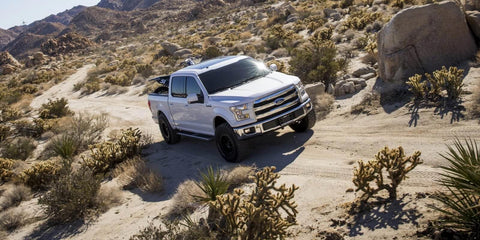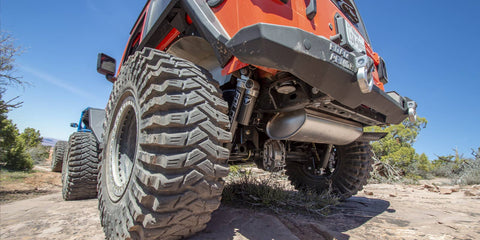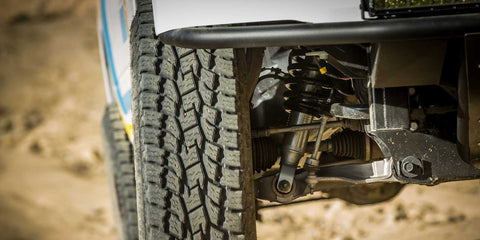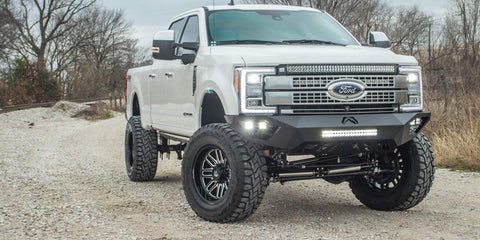Trail Install on Pilot Rock - FOX 2.5 for the 2015 Tacoma
Posted by Sean Reyes on
But Why?!
We ventured up Pilot Rock trail towards Lake Arrowhead, keeping an eye out for a flat shaded spot to perform a key upgrade to our darkhorse 2015 Toyota Tacoma. The lunch break (without any actual lunch) was going to be surgical, changing out the existing ICON Vehicle Dynamics 2.5 coilovers for the Fox Racing 2.5 DSC Coilovers. No better way to get a true before and after feel for the trail than changing out the suspension halfway through!
The Setting
Pilot Rock trail is a mix of rocky slow terrain, whoops, burms, and general unknown ground through the many blind corners around the sides of the mountain. The scenery is changing all the way through, ranging from the normal desert mountain landscape that southern California is known for, to lush green and yellow trees in the valleys. The trail ends at Lake Arrowhead, which is the quintissential gorgeous mountain town with a full lake and active lifestyle. UTVs, dirtbikes, and all forms of 4x4 rigs were on the trail with us.
The Results
"I actually didn't think it would be that big of a difference between the shocks, but the ride is a huge improvement both on the street and on the trail." The hard hits from burms and whoops are softer, rocks and trail obstacles weren't as jolty, and the washboard trails didn't rattle our teeth out.
A setup like the Fox 2.5 with DSC adjustable reservoirs aren't really on the same level as an ICON 2.5 without reservoirs, so its not exactly a fair direct comparison. The Fox featured an additional remote reservoir, and 2 different types of compression adjustments. ICON does have a similar setup available, but only with single speed compression adjustment.
- Low Speed Adjustment is for entry level actions such as side to side handling on the road (body roll), small bumps, washboard trails. These actions dont move the internal piston enough to activate the shock's internal shim stack.
- High Speed Adjustment is for the mid to high-level shock actions such as hitting whoops, burms through the trail, or g-outs when your stomach falls out your bottom unexpectedly on the trail. These actions move the shock through its range of travel enough to activate the shim stack to better control the piston's movement through the shock travel.
We're all a bit skeptical on the differences between suspension systems and how much of a difference valving or adjustability really makes. How can you even tell the differences between suspension setups?
- How much of the terrain are you feeling? Is it lots of small hard impacts that feel jolty? Or is it pretty soft over big rocks and dips?
- Do you get loud bangs on g-outs or very hard hits? You're shock doesn't have adequate compression or rebound damping to prevent max compression or extension in a controlled manner.
Progressive or Digressive vs Linear valving seems to be the hot topic as of late when comparing Fox, Icon, King, and Bilstein shock absorbers. We always ask our customers the most important question, what do you intend for your vehicle?
Coming from the Icon coil-overs, I was concerned I may lose the daily driving comfort of a digressive valve shock by going to a linearly valved shock like the Fox’s. With the ability to adjust the compression settings, I was able to get my daily driving ride quality close to the quality I had with my Icon’s by having both knobs at their softest setting. While the Icons did have a slight edge in comfort while daily driving, the off-road improvements with the Fox’s have been worth its weight in gold for me.
With the DSC system, I can achieve control through many different scenarios; I'm able to load a few hundred pounds of camping gear for the weekend and do some slower overland trails, or have an empty truck and go out to the desert for a day and fly through the faster wide-open desert, all while adjusting for everything in-between. I can firm-up the suspension when I’m loaded with a few hundred pounds of camping gear, camera gear and fuel and soften it up when I feel like taking just a day trip without all the extra weight. And for those days where I have to drive through the potholes and traffic on the streets of Los Angeles, I can have the settings all the way at their softest to have the most comfort possible. All of these things I was not able to do with my previous suspension.
If you're pushing your truck hard, a solid suspension and tires are the only thing protecting your rig from the harsh and punishing environments.
- Digressive tuned shocks (ICON, Bilstein) respond to higher shock travel speed by getting softer in the more extreme ranges. In real world terms this means that you may feel the washboard trails or small rocky obstacles throughout, but as the hits get harder or the truck picks up speed, the damping response feels softer.
- Linear tuned shocks (Fox, King) have a more direct relationship to speed and compression response. So in the real world, these shocks may be softer at the get-go compared to a digressive shoc.
- Progressive tuned shocks are typically reserved for secondary or or bypasss shocks in which as the shock reaches its extreme range the response gets firmer in order to slow down the wheel travel to prevent jolty full droop or max-compression actions.
As you go up the chain in quality of shock absorber technology, your vehicle receives direct benefits in longevity of secondary components (tie rods, ball joints, control arms, bushings, mounts). Being able to balance between vehicle damping in specific scenarios for the required handling characteristics, and ride comfort, goes a long way to preventing future maintenance issues, and peace of mind.






















